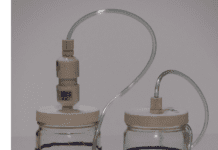These tank makers are no doubt familiar with the construction, installation, and testing recommendations (including pressure-impulse strength tests) published in the American Boat & Yacht Council’s (ABYC) Standards and Recommended Practices for Small Craft”, specifically Sections H-24 (Gasoline Fuel Systems), and H-33 (Diesel Fuel Systems). Your insurance company may require that your boat’s tanks adhere to these recommendations or be otherwise “certified.”
Basically, ABYC standards require that tanks be liquid- and vapor-tight, and withstand the effects of fuel, lube oil, bilge solvents, salt or fresh water, fire, or other hazards Tanks must show, in a certain manner, the maker’s name and address, date made, tank capacity, material specification and thickness, fuel type to be used, maximum test pressure, and other incidental wording one would probably have abandoned ship by then.
By implication it may seem that fire-retardant resins should be used for tanks, but this is often overemphasized and not an ABYC requirement, although at one time it was a requirement under the old BIA standards. Gray claims that ordinary polyester resin will usually withstand the 25-minute fire exposure, and a coat of fire-resistant paint on the outside is optional if you need more peace of mind.
Fire retardant resinsare more expensive, not always easy to find, and more difficult to use, but are acceptable and may be required on large, commercial passenger-carrying craft.
For those not experienced in making FRP tanks and who want to know more about it, the following may prove of interest. Keep in mind, however, that properly made, tested, and maintained fuel tanks are probably a boat’s most important safety feature. Also, remember that FRP tanks are not necessarily light in weight or inexpensive. Even if appealing at first thought by the do-it-yourselfer willing to work with resin and fiberglass, and who may not have the welding skills or equipment to make metal tanks, saving money by making one’s own tank is not always sound advice.
Tank Configuration
One advantage of FRP tanks is that they can be made in virtually any shape to better use a given space. However, general tank size and shape may be provided on the plans by your boat’s designer, and it is common for designers to assume the use of metal tanks. Unless otherwise approved by your boat’s designer, at least the sizes given should be adhered to. The point is, don’t add fuel capacity simply because the space may be available; it could upset the balance, safety, and performance of your boat. On existing boats, the tanks in place may be used as models for custom-made FRP replacement tanks.
Tanks usually require at least one baffle or “slosh plate” between the ends and/or sides to prevent the contents from surging, to improvestrength, and to minimize noise. Baffles should be fitted where any distance exceeds approximately 30 inches so that tank intervals won’t exceed 20 inches maximum, or so that a maximum of three cubic feet (about 20 gallons) exists between baffles.
Baffles can be closed or open, and with snipped corners for the passage of fluid and air (Figure 1). If open, the opening should not be more than 30 percent of the baffle area. Generally, baffles should be the same thickness and structural configuration as the tank sides; in other words, as strong as the tank itself.
Some commercial boatbuilders use aluminum baffles riveted in place with extra FRP laid over these to prevent leaks (similar to Figure 2A). If used, such baffle fastenings should be no more than 3 inches apart; bed the area in mat and cover with mat on both sides to at least .20 inches thick, in any case.
Tank surfaces should be shaped so as not to trap moisture, especially on top around fittings (on gasoline tanks, fittings must be located on top), Thus tops should be domed, cambered, curved, or sloped rather than horizontally flat, which may tend to dish or droop (Figure 3). Curved, corrugated, or surfaces that are not otherwise flat make for a stronger tank. Flat surfaces are acceptable, but they should be inclined and made thick enough, or otherwise stiffened, to prevent bulg as listed in the standards.
The ABYC standards also discuss venting, fill fittings, installation methods, and the like. However, don’t expect much in the way of information from the standards about fiberglass reinforced plastic (FRP) tank construction or design, especially compared to the more comprehensive information provided for metal tanks. It’s not that the ABYC doesn’t accept FRP tanks; they do, and in fact, major builders such as Bertram and Hatteras use UL-approved FRP tanks for both gasoline and diesel fuel. Furthermore, it’s the personal opinion of ABYC Technical Director, Lysle Gray, that FRP is the best tank material, and he has the experience to back it up.
Gray was involved in making early FRI’ boat tanks some years ago. One such tank was inadvertently “tested” by a fire that devastated the facility where the tank was, but the tank itself survived virtually unscathed. Made with 1 /&inch skins of mat and woven roving on each side of a balsa core, the tank sustained charring damage to the outer skin, but the core and tank interior were not harmed. Resin was burned from the mat, while the charred woven roving seemed to act as a barrier which kept the core from burning, according to Gray.
When asked about the affect of heat on the core, Gray noted that damage may have occurred, which means that had a foam material such as PVC been used instead, it might have deformed or worse, resulting in other problems or possibly a complete failure of the tank.
Another report some years ago involved a similar blaze where an FRP tank containing gasoline in a boat survived and did not ignite, even when adjacent metal tanks in other boats exploded and burned.
-By Ken Hankinson
*** For the this entire article please click on the link below…
Can You-Should You-Build Your Own Fiberglass Tanks?


































